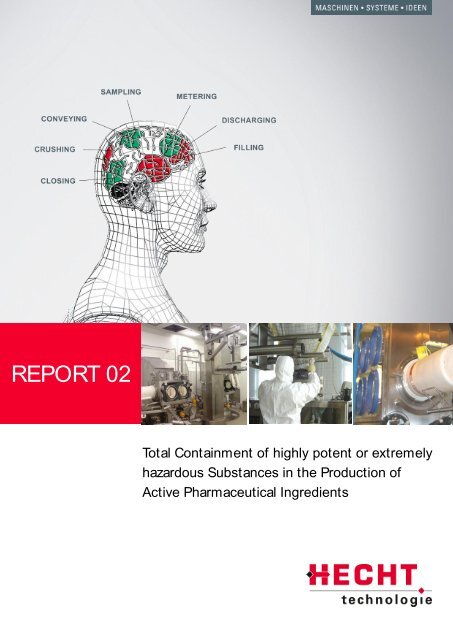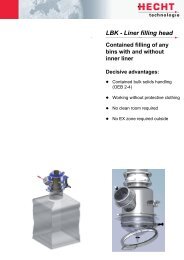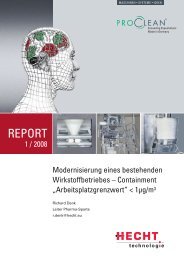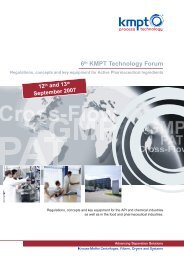Report 02 Download PDF - HECHT Technologie GmbH
Report 02 Download PDF - HECHT Technologie GmbH
Report 02 Download PDF - HECHT Technologie GmbH
You also want an ePaper? Increase the reach of your titles
YUMPU automatically turns print PDFs into web optimized ePapers that Google loves.
REPORT <strong>02</strong>Total Containment of highly potent or extremelyhazardous Substances in the Production ofActive Pharmaceutical Ingredients
REPORTProduct and operator protectionAn active pharmaceutical ingredients (API) manufacturerrises to the challenge of production and handling of APIand implements a flexible containment solution, togetherwith <strong>HECHT</strong>.Due to the increasing number of products in the API and pharmaceuticalindustries that are classified as high potent or highrisk, the authorities are more demanding in terms of productand operator protection. Especially in the production of cytostaticand teratogenic substances, antibiotics and other criticalproducts, the authorities are extremely concerned withtolerating the production in multi purpose facilities, wherelatter products are being handled openly, even if only for ashort period of time.Customised solutions by <strong>HECHT</strong>The expansion process involved the development of technologythat was specially tailored to the customer’s needs. Thefact that the API manufacturer was unable to find the appropriatetechnology on the market led to <strong>HECHT</strong> <strong>Technologie</strong><strong>GmbH</strong> to be commissioned to develop an appropriate containmentsystem. The maximum Occupational Exposure Limit(OEL) was defined at 370 nanograms/m3, the maximum batchof product was set at 350 kg. Along with the client, requirementspecifications for the bulk solids transfer were developed. Theobjective was to design a centralized weighing system forthe transfer of small and large quantities into bundles,suitable for in-house supply, as well as weighing thefinal products.<strong>HECHT</strong> Containment PyramidThe cleaning of equipment in multi-purpose facilities constitutesanother challenge. To be equipped for the production ofhighly hazardous substances, it was a priority of the API manufacturerto be provided with the utmost degree of flexibility andcontainment (closed systems). Together with <strong>HECHT</strong>, they hadalready been able to gain experience in the field of API containmentbefore, when they had implemented the initial stageof expansion of the manufacturer’s facility. The cleaning andmaintenance, as well as the enormous servicing costs for thecontainers posed another challenge.The production facility consisted of a total of six reactors, whichwere supposed to be charged in three separate rooms. Afterthe drying process, the substances needed to be filled into asafe container. The different concepts were evaluated in a matrixusing carefully generated risk assessments. After twomonths of preliminary planning, the decision was made in favorof FIBCs to be the suitable containers. These FIBCs were custom-madewith specially designed inlet and outlet connectorsto be safely coupled with the isolators.2
Flexible containment solution using FIBCsThe decision to use flexible single-use systems (i.e. FIBCs)proved to be the correct decision throughout the entire project.The crucial reasons were:The product output from the FIBC is guaranteed, evenwith products that display poor-flow characteristics.FIBCs do not have to be cleaned after use, as they areonly used as single-use systems.Acquisition of FIBCs means lower prices compared tothe costs of cleaning rigid receptacles, e.g. containers.When using FIBCs, there are no costs that come up formaintenance and repair.FIBCs use up less storage area compared to otherreceptacles.The deployed FIBCs consist of an outer liner and a dual antistaticfoil inner liner. A crucial point in the development of thisinnovative containment technology was to allow for the FIBCsOverview of production facilityFIBC in a frameto be filled and emptied in a contained manner. Extensivetests followed to determine the design of the FIBCs. To complywith the OEL of 370 nanograms/m 3 , it was decided to adda second inner liner connection piece to both the inlet andoutlet systems of the FIBC. These specifically designed FIBCinlet and outlet systems are connected using isolator technology.API production facility3
REPORTTransferIn order to provide maximum flexibility, all features had to bemodular. Both the metering system and the communition systemhad to be exchangeable, to guarantee flexibility for productchanges or varying product characteristics.Customised solutions by <strong>HECHT</strong>To connect the exterior outer liner of the FIBC, a connectionadapter was installed in the upper area of the isolator. Theinner liner (product liner) is connected from within the isolator.Isolator for transferring the product into various containersA product transfer isolator was installed in the transferringroom. This isolator transfers the final product from the productionplant into smaller intermediate containers, which are thenhauled to the pharmaceutical production company for formulation.The product transfer isolator is also used to transfer theproduct from one intermediate container (i.e. FIBC) into anotherintermediate container (i.e. FIBC). This transfer is necessarydue to the fact that the dryers have to be completelyevacuated, and only the actual product is registered in theintermediate container (FIBC). Subsequently, the exact quantityfor the next production step is provided by the transferisolator in another intermediate container (FIBC). In order toperform all these tasks with the transfer isolator, a wide varietyof features had to be integrated:A product metering system for weighing both large andthe smallest of quantities. For weighing small and extrasmall quantities, a weighing system had to be integratedinto the isolator. For filling larger quantities in toFIBCs, a scale was installed, located underneath theisolator.A communition system was required in the isolator, inorder to be able to break up product agglomeration, toallow further dosage.<strong>HECHT</strong> patented solution: docking the FIBC with twoliners to the isolatorThe isolator is protected through a RTP (Rapid Transfer Port)from inside out.4RTP (Rapid Transfer Port)
Similar to the discharging process, the same technology wasused for the filling process of the FIBCs underneath the producttransfer isolator - only in mirror-inverted version. The RTPis used to lock components in and out of the isolator. For thefilling of smaller quantities, a scale for small quantities islocked in through the RTP to enable the product to beweighed and filled it into small bags. Furthermore, a containeris docked to the RTP in order to remove the packed bags fromthe isolator and to transfer them safely to the pharmaceuticalproduction facility for further processing. A small mobile carriageinside the isolator is used to slide the sealed productbags into the canister that is attached on the side of the RTP.All parts in the isolator have to be easily removable. Theweight of each component is limited to 10kg, the size and constructionof each part must allow for safe handling from and tothe RTP port, using the gloves attached to the isolator. TheRTP port sets the standard for the maximum size of eachcomponent used. The maximum diameter of any componentmust not exceed 350mm to ensure that they fit through theRTP into the canister for locking out. All drivers (metering systemand communition) are located outside the isolator. Forthis purpose, plug-in connections in hygienic design are attachedat the rear side of the isolator. To meet all these requirements,computerized feasibility studies, as well as otherintensive studies were carried out, using both 3D models andmodels for testing with operating personnel. Different bodyheights of the personnel had to be considered to ensure convenientaccess to the isolator. Accordingly, a height-adjustableoperating platform was provided, that allowed all proceduresto be accurately and ergonomically executed. This meant thatall gloves of the isolator were accessible for all operators, regardlessof height. For security reasons, the platform wasframed with safety glass. This enabled the operator, as well asother personnel from outside the room, to have a clear viewon the isolator.The isolator is also fitted with cleaning nozzles and additionallyintegrated hand spray guns. The position of the nozzleswas specified using computer software. The correspondingCIP system (Clean In Place), together with the tubing for thecleaning medium and the drying air, was planned and supplied.The unit was installed outside the room in the technicaldepartment. The drainage for the cleaning fluid is located atthe bottom area of the isolator.The frame also features a pick-up and positioning device forthe FIBC to be elevated using a lifting column. For easier connectionof the FIBC outlet system to the isolator, the frame issplit in two parts. This has the benefit that only the top part ofthe frame, with the FIBC attached, is lifted, whereas the bottompart remains on the ground. This offers more space tooperating personnel when connecting the FIBC outlet to theisolator.The FIBC is then lifted up to the connection adapter of theisolator, using the lifting column that is mounted alongside theisolator. The lifting column is equipped with a pneumatic massagingmechanism, to be used with poor-flowing products.This mechanism can be adjusted in height. The height adjustmentcomes to use when flexible containers deform duringdischarging, meaning that the pneumatic massaging mechanismmust be readjusted. The lifting column had to be manufacturedfrom stainless steel, due to the frequent cleaning ofboth the equipment and the work space.The FIBCs used for the transportation of the products are providedin frames and kept ready for further use. The frames areutilized for better handling of the flexible containers usingmanual lift trucks, as well as for damage protection duringhandling.Product Transfer Isolator5
REPORTAPI production ranging from charging the reactor todischarging the dryerA total of six reactors are installed in the production facility.One compartment respectively contains two reactors. For theprocess of filling, each reactor was equipped with an isolator.To protect the connection from the isolator to the reactor(pressure tightness, smooth product flow and solventresistant),a specially designed ball segment valve was installed.A central lifting column is located between two reactors, thatlifts the framed FIBCs and places them on top of the respectiveisolator. Similar to the design in the transfer room, thelifting column is equipped with a pneumatic massagingmechanism to ensure secure and accurate discharging, evenwhen handling products with poor flow characteristics. Theconnecting systems for docking the FIBC outlets are identicalto the systems used in the transfer room. As a result of themock-ups conducted prior to the installation of the equipment,the size of the isolators was kept to a minimum to allowfor simple and fast cleaning. Additionally, a hygienic meteringrotation flap was installed to discharge the product in a controlledmanner.Charging a reactor using a lifting columnDischarging a dryer into FIBCsAnother isolator, that is used for charging the FIBCs, is installedunderneath the dryer. The same method as for dischargingthe FIBCs was used. Since the FIBC filling systemis located one level below the dryer, the isolator was installedas close as possible to the dryer outlet. This does not onlyminimize the product drop height, but also simplifies thecleaning of the down pipe. It was important to reduce the sizeof all parts to be cleaned to a minimum, even if additionalequipment had to be used.FIBC connected to isolator for discharging6As a result of the short down pipe, staff was not able to operatethe isolator from the ground anymore. Furthermore, theFIBC had to be lifted in order to be connected to the isolatoroutlet. Therefore, an operating platform became necessary for
the operator. For the precise positioning of the FIBC, a liftingcolumn, with a loading platform for the frame was installed underneaththe isolator. The lifting column lifts the loading platformwith the empty FIBC already in place, and moves it in positionfor connection. A weighing unit was integrated in theloading platform to allow for the FIBCs to be weighed after filling.Integrated automatic samplingAutomatic and validated sampling was required during theprocess of discharging the dryer. Therefore, a sampling systemwas installed in the down pipe. For product extraction, thesampling system contains a small pan that is moved into thedown pipe using a positioning unit. Once the sample pan isfilled, the unit retreats into the sampling system and, with a rotationof 180°, empties the content into a sample container locatedin the isolator. This process is repeated until the samplecontainer is full. The filling of the pan is controlled by the dischargingprocess of the dryer. This allows for selective sampling,which reflects a representative cross-section of the entireproduct in the FIBCs. The sampling system also features anintegrated cleaning unit.Filling a FIBC connected to an isolatorTaking samplesDropping samples7
REPORTFAT with measurement of the Occupational Exposure LimitTwo rooms were built altogether. One room with two isolatorsrepresents the compartment for charging two reactors, theother room is used for discharging the dryer. After the roomshad been cleaned thoroughly, no personnel was allowed entrybefore measurements started.A surge drum was installed on top of the room in order to beable to fill the lactose into FIBCs. The discharging system forthe FIBCs filled with lactose was established outside the finalassembly hall to prevent contamination inside the building.Before measurements were launched, the lactose was transferredinto the surge drum using a pneumatic conveying system.The surge drum served as a dryer.The measuring process was documented using video recording.According to the ISPE guidelines, IOM-Samplers wereused. These samplers were positioned close to the operator’srespiratory system, on the operator’s gloves, on the filters inMeasuring roomDuring the planning of the project, preparations were made totest the engineered systems in a Factory Acceptance Test(FAT) and to verify the specified Occupational Exposure Limits(OEL). A lactose free environment had to be set up in the finalassembly hall, in order for the measurements to be conductedaccording to the ISPE-SMEPAC-baseline guide. Lactose islisted as a reference product in the ISPE baseline guide. Theinstallation conditions resembling those of the projected APIfactory were simulated using a wooden construction. Thewooden structure was surrounded by another wooden construction,constituting the measuring room. After all componentshad passed quality control and various performancetests, the wooden construction was sealed with foil. All openings,for example cable feedthroughs, were sealed. After that,the ventilation unit was connected. As described in the ISPEguidelines, multiple air exchanges had to be conducted insidethe measuring room, using H14 (HEPA14) filtered air. An airlockwas also installed, where operators had to put on protectiveclothing before entering the measuring room, to preventany lactose contamination from the outside into the measuringarea. The equipment inside the measuring room was cleanedusing purified water.8Monitoring pointthe isolator at both docking stations and in the room itself. Thefirst measurements were conducted without any lactose in use,in order to be able to measure the concentration of lactose athand. Afterwards, three consecutive measurements with thelactose stored in the surge drum were carried out. The FIBCsfilled with lactose were then transported into the other room fordischarging. After that, the same measurements were conducted.After all measurements were carried out, critical areasin each compartment were tested using wipe tests, in order todocument any lactose deposits on the different surfaces.Thereafter, all samples were sealed and sent off for analysis toa laboratory in the US, which, at the time, was the only laboratorythat could analyse lactose with an OEL of up to 5nanograms/m 3 . The results that were received after six weeksexceeded all expectations. Almost all samples were below thelimit of 5 nanograms/m 3 , meaning an OEL of less than 100nanograms/m 3 for the operator (see test record).
Custom-made FIBCs provide High ContainmentThe FIBCs, designed and engineered by <strong>HECHT</strong> <strong>Technologie</strong>,are the result of a nearly two-year-long study, conducted onadequate container systems to be used for the API industry.The inner liners used in the FIBCs meet the CFR (Code ofFederal Regulations) and thus are in conformity with the FDA,meaning they are electrically conductive and resistant to mostcommonly used solvents. Furthermore, the FIBCs were examinedusing a patented foil-welding method and found to be100% leak proof. This ideal solution allows to fill, dischargeand transport even the highest of hazardous substances in thesafest way possible.Exemplary planning reduces overall planning and manufacturingcostsOn the basis of end-to-end planning from one source, acquisitioncosts could not only be reduced dramatically, in contrast tothe costs estimated by the client, but implementation and installationwere also completed earlier than scheduled. Thefewer instances involved in planning a containment facility, themore efficient and cost-effective the performance. No informationis lost between the client and the planning administrator,and fewer or no errors are being made. This is due to the directcommunication between the expert and the client, where theoverall plant concept is thoroughly reviewed. The planning andimplementation costs originally calculated by the client hadbeen undercut by about 30%.Comparison of the total investment and life cycle costTest record9
Status: 10/2011Additional Containment Solutions by <strong>HECHT</strong>High-Containment LinerConnection System LASfor the discharging ofFIBCsContainment Sack DischargingStation with endless-linerportsfor contamination-freedischarging of sacksModular Filling Stationwith endless liner forclean and safe filling intosmall containersFlexible Expendable WeighingIsolator EWI for transferring andweighing small quantitiesPlanning, providing and installing complete containment solutions - from one sourceAlongside single components, <strong>HECHT</strong> is, on the basis of many years of experience and know-how in the field of containment,your competent partner for complete solutions of various processes in the chemical, pharmaceutical and API industry.<strong>HECHT</strong> <strong>Technologie</strong> <strong>GmbH</strong>Schirmbeckstraße 1785276 Pfaffenhofen / IlmGermanyTelephone +49 84 41-89 56-0Fax +49 84 41-89 56-56emailInternetinfo@hecht.euwww.hecht.eu







